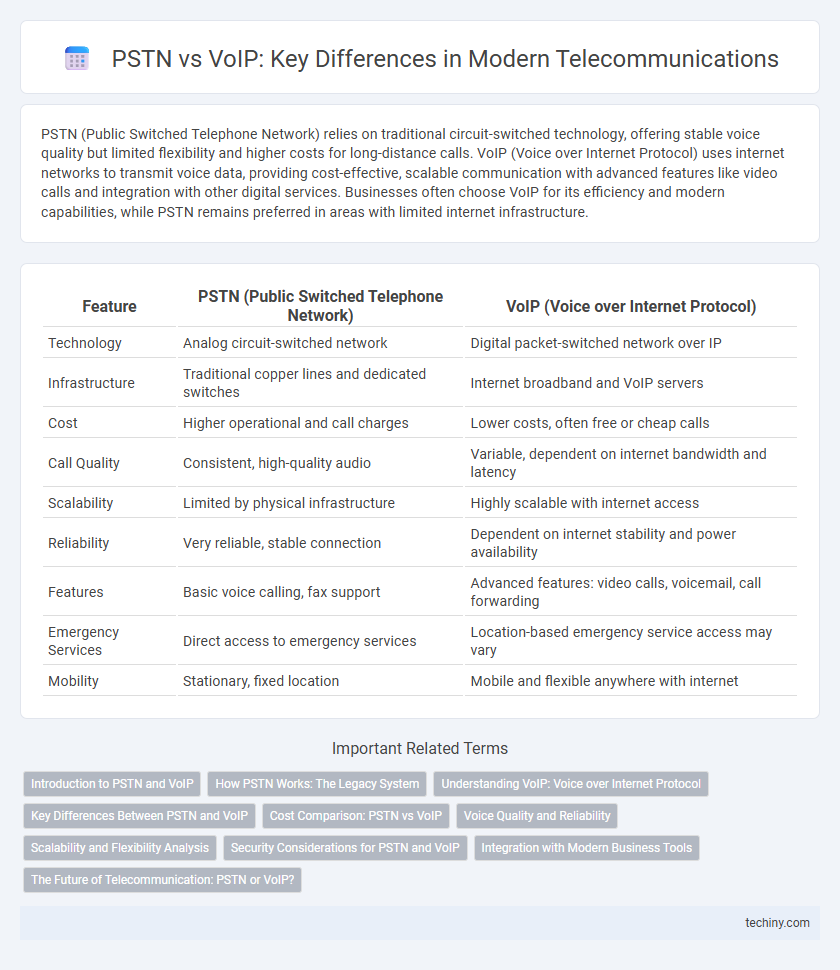PSTN (Public Switched Telephone Network) relies on traditional circuit-switched technology, offering stable voice quality but limited flexibility and higher costs for long-distance calls. VoIP (Voice over Internet Protocol) uses internet networks to transmit voice data, providing cost-effective, scalable communication with advanced features like video calls and integration with other digital services. Businesses often choose VoIP for its efficiency and modern capabilities, while PSTN remains preferred in areas with limited internet infrastructure.
Table of Comparison
| Feature | PSTN (Public Switched Telephone Network) | VoIP (Voice over Internet Protocol) |
|---|---|---|
| Technology | Analog circuit-switched network | Digital packet-switched network over IP |
| Infrastructure | Traditional copper lines and dedicated switches | Internet broadband and VoIP servers |
| Cost | Higher operational and call charges | Lower costs, often free or cheap calls |
| Call Quality | Consistent, high-quality audio | Variable, dependent on internet bandwidth and latency |
| Scalability | Limited by physical infrastructure | Highly scalable with internet access |
| Reliability | Very reliable, stable connection | Dependent on internet stability and power availability |
| Features | Basic voice calling, fax support | Advanced features: video calls, voicemail, call forwarding |
| Emergency Services | Direct access to emergency services | Location-based emergency service access may vary |
| Mobility | Stationary, fixed location | Mobile and flexible anywhere with internet |
Introduction to PSTN and VoIP
PSTN (Public Switched Telephone Network) is a traditional circuit-switched telephone network that uses dedicated physical lines for voice communication, ensuring high reliability and consistent call quality. VoIP (Voice over Internet Protocol) transmits voice data over IP networks, enabling flexible, cost-effective communication by converting analog voice signals into digital packets. Both technologies serve essential roles in telecommunications, with PSTN dominating legacy infrastructure and VoIP driving modern, internet-based voice services.
How PSTN Works: The Legacy System
PSTN operates through a global network of circuit-switched telephone lines, enabling voice communication by establishing dedicated connections between callers for the duration of a call. It relies on analog signals transmitted over copper wires, traditional telephone exchanges, and signaling protocols like SS7 to manage call setup and teardown. Despite its reliability and widespread infrastructure, PSTN's fixed bandwidth and physical line dependency limit its flexibility compared to modern IP-based systems.
Understanding VoIP: Voice over Internet Protocol
Voice over Internet Protocol (VoIP) transmits voice communications over internet networks, bypassing traditional Public Switched Telephone Network (PSTN) infrastructure and reducing costs. VoIP converts analog voice signals into digital data packets, enabling efficient, scalable, and feature-rich telephony services such as video calls, voicemail, and call forwarding. With Internet Protocol (IP) networks as its foundation, VoIP supports integration with modern communication platforms, enhancing flexibility and accessibility across devices and locations.
Key Differences Between PSTN and VoIP
PSTN (Public Switched Telephone Network) relies on traditional circuit-switched technology, providing dedicated voice channels with consistent call quality, while VoIP (Voice over Internet Protocol) uses packet-switched networks to transmit voice as data packets over the internet, enabling cost-effective and flexible communication. PSTN requires physical infrastructure such as copper wires and telephone exchanges, whereas VoIP operates through broadband connections and software applications, reducing hardware dependency and offering advanced features like video calls and integration with other digital services. Call quality in PSTN is stable due to reserved bandwidth, but VoIP performance depends on internet speed and network latency, which can affect voice clarity and call reliability.
Cost Comparison: PSTN vs VoIP
VoIP systems significantly reduce communication expenses by utilizing internet protocols, eliminating fees associated with traditional PSTN lines, long-distance charges, and maintenance costs. PSTN requires substantial infrastructure investment and ongoing operational expenses due to dedicated circuit-switched networks, while VoIP leverages packet-switched networks that optimize bandwidth usage. Businesses adopting VoIP benefit from scalable pricing models and lower total cost of ownership compared to the fixed and higher costs inherent in PSTN.
Voice Quality and Reliability
PSTN provides superior voice quality and reliability through dedicated circuit-switched networks, minimizing latency and packet loss. VoIP depends on internet connectivity, making voice quality variable due to bandwidth fluctuations and potential packet delays. Enterprises valuing consistent call clarity often prioritize PSTN, while VoIP suits flexible, cost-efficient communication with occasional quality compromises.
Scalability and Flexibility Analysis
PSTN networks offer limited scalability due to rigid infrastructure and physical line dependencies, making expansion costly and time-consuming. VoIP systems provide high scalability by leveraging IP networks, allowing rapid addition of users and services without significant hardware changes. Flexibility is enhanced in VoIP through software-based configurations, ease of integration with other digital services, and support for mobile and remote connectivity.
Security Considerations for PSTN and VoIP
Security considerations for PSTN revolve around its inherently closed and circuit-switched network, which offers strong protection against common cyber threats such as hacking and eavesdropping. In contrast, VoIP operates over IP networks that are vulnerable to risks including packet interception, malware attacks, and denial-of-service, necessitating robust encryption protocols like SRTP and secure authentication methods to safeguard communications. Effective security management in VoIP requires continuous monitoring and timely software updates to mitigate vulnerabilities inherent in Internet-based telephony systems.
Integration with Modern Business Tools
VoIP systems seamlessly integrate with CRM platforms, collaboration tools, and cloud services, enhancing communication efficiency and data accessibility for modern businesses. PSTN infrastructures lack native compatibility with digital business applications, limiting automation and real-time analytics capabilities. The adoption of VoIP enables unified communication strategies, supporting scalable and flexible workflows critical for digital transformation.
The Future of Telecommunication: PSTN or VoIP?
VoIP technology continues to surpass PSTN by offering cost-efficiency, scalability, and integration with IP-based services, positioning it as the leading solution in modern telecommunications. Telecommunications providers are increasingly investing in VoIP infrastructure due to its enhanced flexibility and compatibility with emerging 5G networks. Despite PSTN's reliability in legacy systems, the global shift toward all-IP networks signifies a future predominantly driven by VoIP advancements.
PSTN vs VoIP Infographic

 techiny.com
techiny.com